Thyssen-Bornemisza - Angels
last update: 20 Nov. 2019
In early May 2019 we had our first visit to the Museo Nacional Thyssen-Bornemisza in Madrid. According to Wikipedia it is home to 1,600 paintings that "fills the historical gaps in its counterparts' collections", i.e. The Prado and the Reina Sofia which are both just next door.
There was no way we were going to look at 1,600 paintings, so either you go for the masterpieces, or you try to pick out a theme, or you just wander round aimlessly. So this webpage is all about visiting the Thyssen-Bornemisza museum with the theme of 'Angels'. Why pick 'Angels'? One of the wonderful things about this museum is that you can take photographs, and one of the first photographs I took was of some Angels. So I decided to (a) take some snaps of anything I liked, and (b) snap some Angels. If you input 'Angels' into the museums website it will tell you that the collection has only one painting about Angels, and it's 'El rapto del ángel' by Antonio Saura (1930-1998). Which is odd because I found lots of Angels, and never even saw the painting by Saura!
Angels
Wikipedia has a whole webpage on Angels in Art, and I learned:-
Angels are usually intended, in Christian, Hebrew and Islamic art, to be beautiful.
Angels are supposed to be genderless, but Gabriel appears in the "likeness of man".
The first know depiction of an Angel dates from the mid-3rd C AD, and it is Gabriel without wings.
The earliest known representation of Angels with wings dates from ca. 379-395 AD.
At the time it was suggested that Angels did not have wings, but that only Gabriel had wings to suggest the sublimity of his nature.
But from then on, Angels more or less always had wings.
My view, until now, was that an Angel just looked like a person with a halo and wings. Frankly I did not expect angels to be such a complex subject, and to keep it as simple as possible I'm going to stick to the Christian view of angels.
According to a webpage on the appearance of angels in icons the word Angel is from the Greek word meaning messenger, and this is reflected in the idea that we see Angels as messengers from God. However, some texts prefer to consider Angels as bodiless spirits, but having their own will and intellect (rather than being just an aspect of God).
Would you believe that there is a Wikipedia webpage only on christian angelology. The most complete description of Angels is attributed to The Celestial Hierarchy of the late 5th C AD theologian Pseudo-Dionysius. There are also Wikipedia webpages on Angels in Judaism and Angels in Islam.
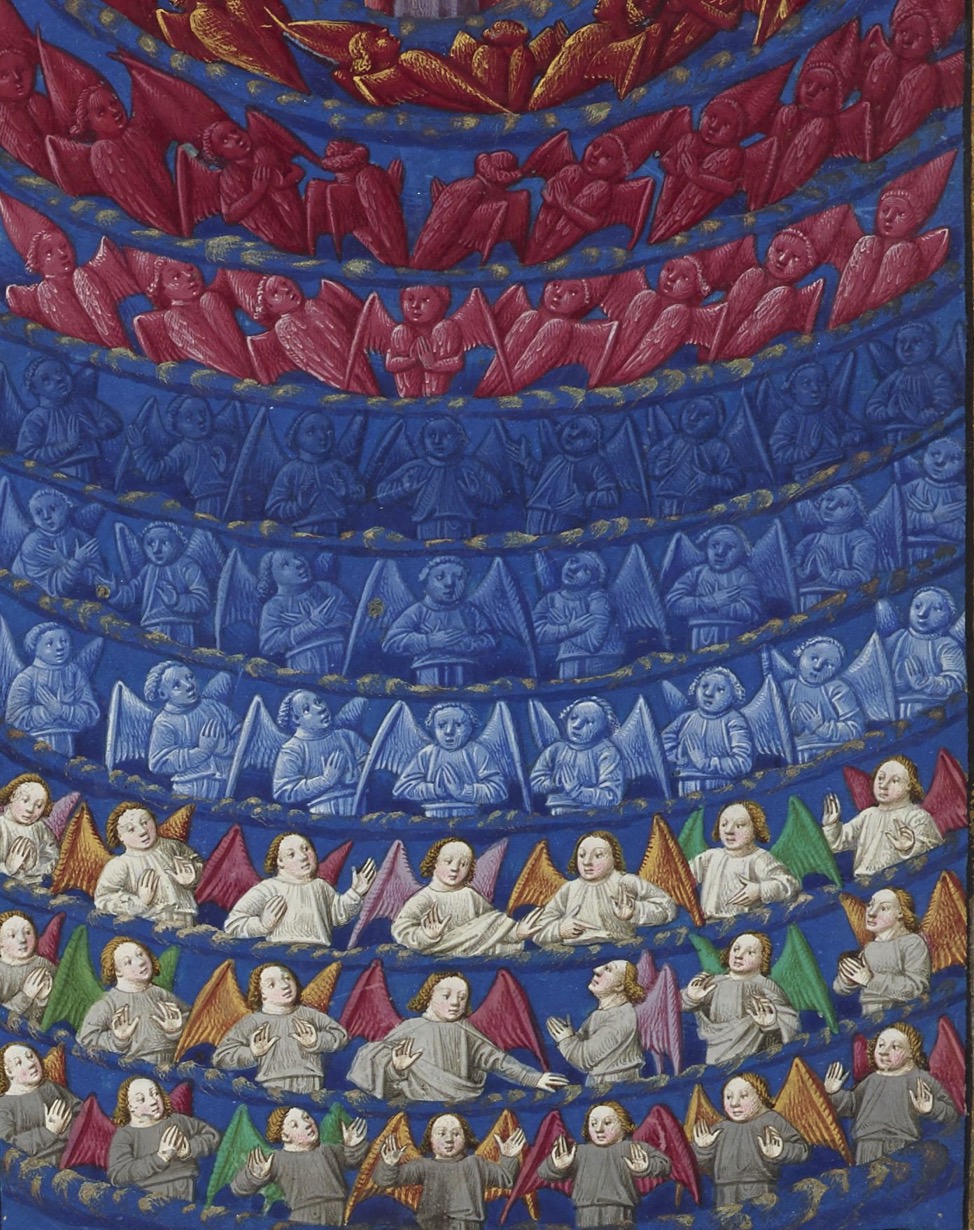
Above we have just one view of the different types of Angels, and it's taken from 'Le Mirouer Historial' in the manuscript of 'Vincent'.
According to medieval Christian theology, there are several different types of Angels. In some texts there are three hierarchies or 'spheres' of Angels, and nine 'orders' or 'ranks' or 'choirs' of Angels. Of course there could be other types of Angels, which have not been revealed to us yet. Each type of Angel has different characteristics, but many of these Angels don't appear much in icons or paintings.
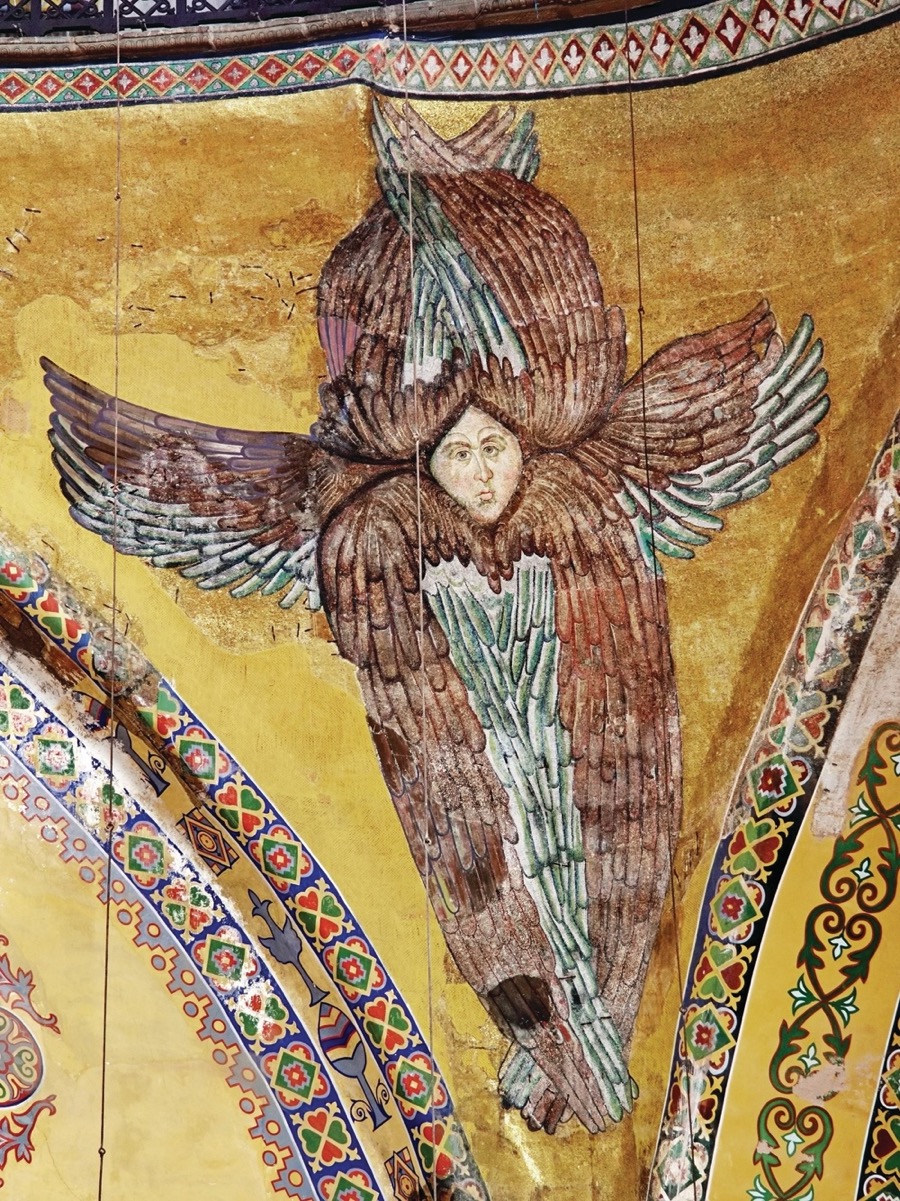
Above we can see a 700 year old mosaic from the Hagia Sophia that was cleaned in 2010, revealing the face of a Seraph. It is said that the six wings represent the six days it took to create the Earth. The face on this Seraph is around 1 meter wide.
The 'first sphere' is of angels that serve God, e.g. Seraphim (the 'burning ones') are caretakers of God's throne, and are of the highest rank in Christian texts. They are described as six-winged flame-like beings that fly around (or above) the Throne, and in some texts they cover their faces with one pair of wings, cover their feet with another pair of wings, and fly with the third pair of wings. According to some texts only the Virgin Mary and the Archangel Michael have direct access to the Seraphim, and the Virgin Mary has access to God through Jesus without using any Angels. The Seraphim gather prayers and bring them to the Virgin Mary, who gives them directly to God through Jesus. These wings can appear today as ceremonial fans which often will have an image of a Seraph on them.
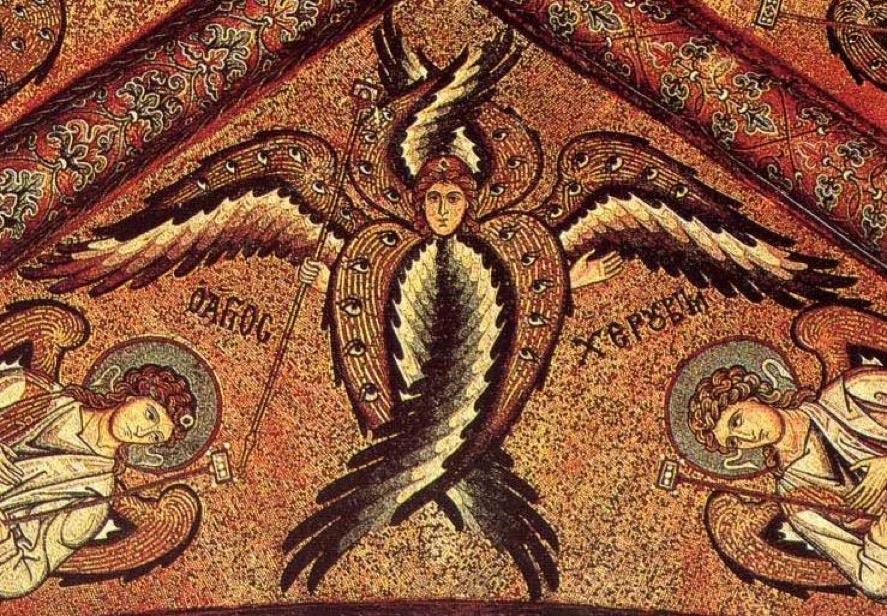
Above we have a Cherub from Cefalu Cathedral in Sicily, it's dated to ca. 1200.
Cherubim guard the way to the tree of life and God's Throne, and originally they prevented Adam and Eve from returning to the Garden of Eden (they are second only to the Seraphim). They are infinite in number and were first imagined as guards with flaming swords, before (mistakenly) becoming cute babies with wings. The image of a chubby winged baby with white wings appeared during the Renaissance, and were mistakenly named cherubs whereas they are actually putti.
The origin of the name Cherubim comes from Assyrian and means 'to be near', so like a bodyguard or servant. Because of their closeness to God Cherubim are often shown as 'all-seeing', with numerous eyes on their wings. This closeness to God is supposed to give them a great understanding or wisdom. Cherubim magnify the holiness and power of God, but there are warnings not to make the mistake and worship Angels.
The example shown above is actually quite discrete and looks a bit like a Seraphim. But there are other descriptions that clearly suggest that Cherubim were/are decidedly strange.

Cherubim had the likeness of a man but each had four faces, and each one had four wings. Their hands were under their wings on their four sides. The likeness of their faces was that each had the face of a man, and each of the four had a face of a lion on the right side, and each had a face of an ox on the left side, and each of the four had the face of an eagle. Their appearance was like burning coals of fire, and out of the fire came lightning. The image above is of a tetramorph Cherub, typical of Eastern Orthodox iconography.
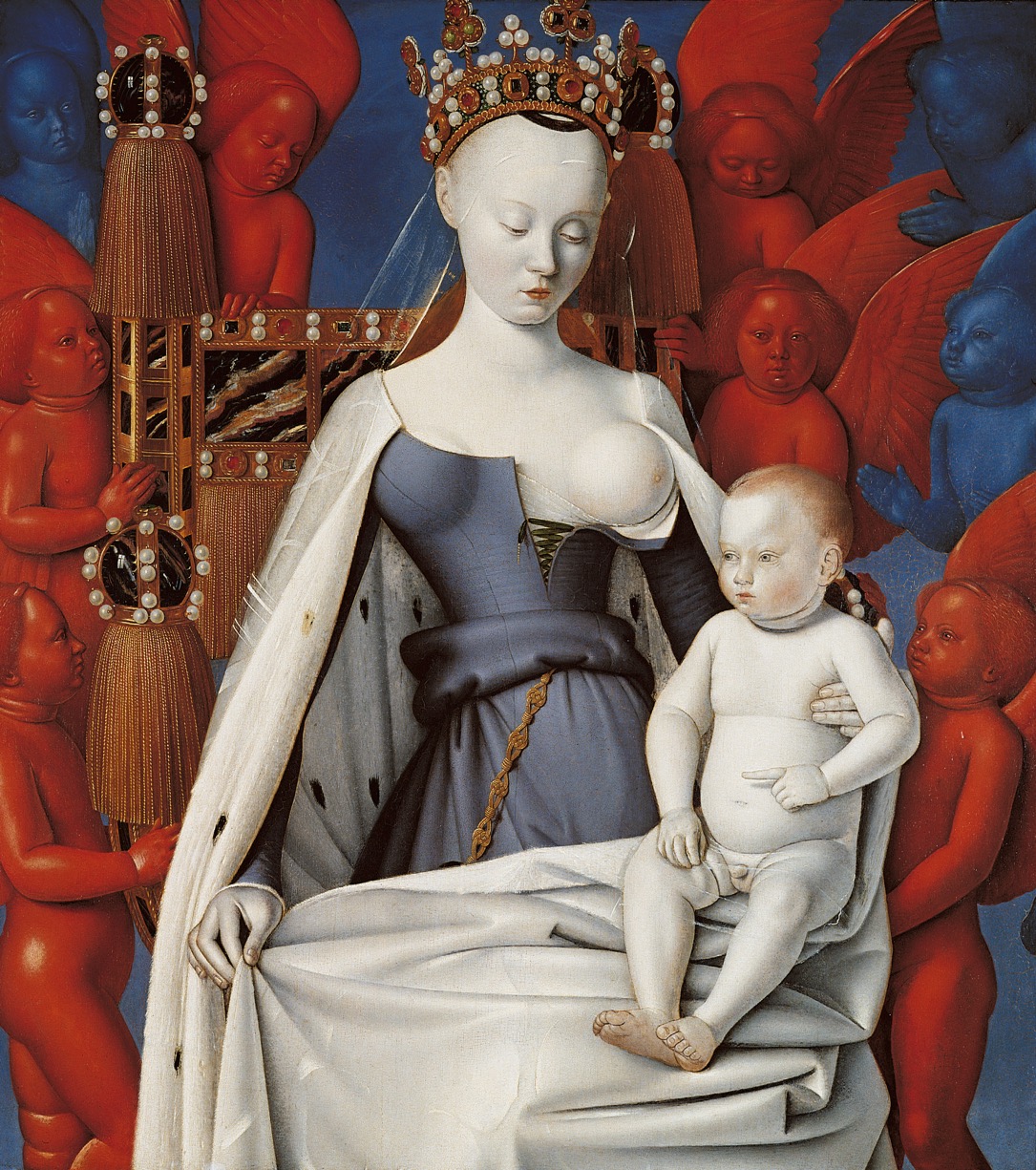
Cherubim and seraphim both derived from Persian art, and usually only appear in a heavenly context, i.e. in the sky or on domes in churches, etc. Both Cherubim and Seraphim were often depicted in a fiery red, but Cherubim can also appear in blues or greens (blue for the heavenly realm and green for the Holy Spirit). Above we can see the red Seraphim and the blue Cherubim together on the right panel of the Melun Diptych by Jean Fouquet (1420-1481). In fact orthodox iconography often presented both Cherubim and Seraphim with six wings and eyes, and sometimes either could be presented with or without eyes.
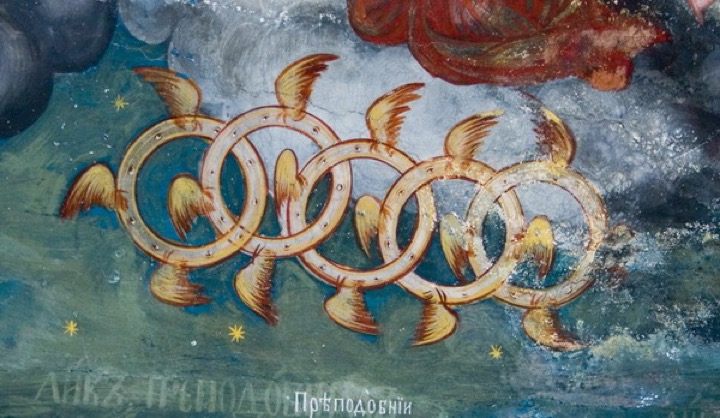
Then there are the Thrones or elders who symbolise God's divine justice and supreme authority. They can also be called the Ophanim, who appear to guard God's Throne. In some texts they note that Ophanim or Offanim in Hebrew is another name for Thrones. The Thrones are not seen that much in paintings but sometimes they are presented as 'wheels' containing many eyes, perhaps because the Throne of God is moved by four wheels. So they are attached too and function as the actual chariots of God, which are driven by the Cherubim.

These are two Thrones (nicely indicated in the mosaic) from the ceiling of the Baptistery San Giovanni in Florence, from ca. 1300.
God rests on the Thrones, which are of an indefinite number. Thrones are under the direct control of Jesus, but they are always in the presence of God. Thrones are also friends of the planets, and reside where matter begins to take shape.

This is a Dominion by Guariento di Arpo (ca. 1310-1370). At a first glance it may just appear like any Angel, but I think the feathered wings and the orb and sceptre point to the fact that it is a Dominion.
The 'second sphere' appears to involve Dominions (or Lordships), which are Angels of leadership and who regulate the duties of lower angels. In this sense they make known the commands of God. They look to be "divinely beautiful humans with feathered wings". It is through them that the majesty of God is revealed. Dominions tell us that only those who serve God are fit to rule others. The Dominions have a pair of feathered wings, but they also wield orbs of light fastened to the heads of sceptres or on the pommel of their swords.
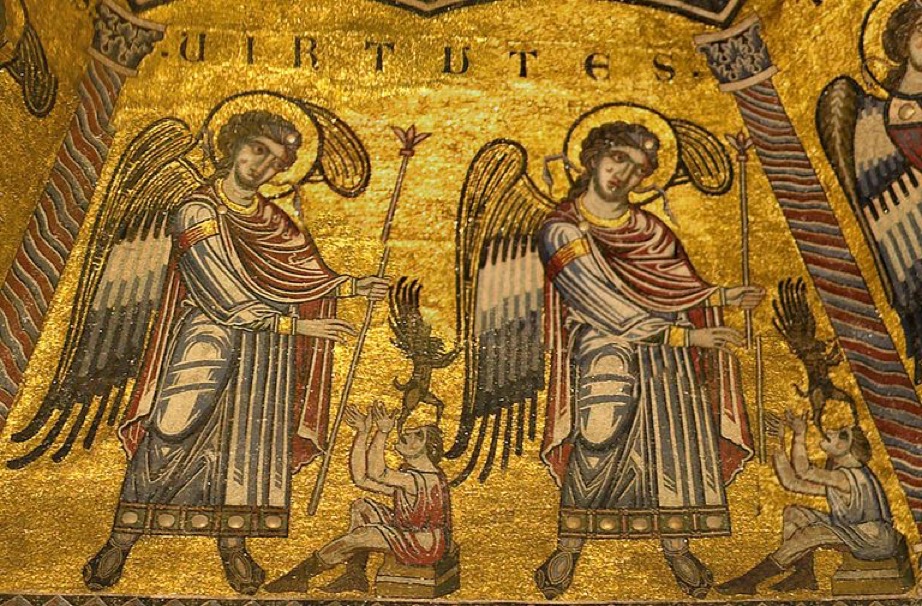
These are two Virtues (nicely indicated in the mosaic) from the ceiling of the Baptistery San Giovanni in Florence, from ca. 1300.
There are also the Virtues (or Strongholds) who provide the signs and miracles seen on Earth, but they also govern and order the laws that created the universe, i.e. supervise the movement of heavenly bodies and keep the cosmic order. They control the elements, i.e. the seasons, stars, the sun and moon, etc. Virtues are the instruments through which God works his miracles.
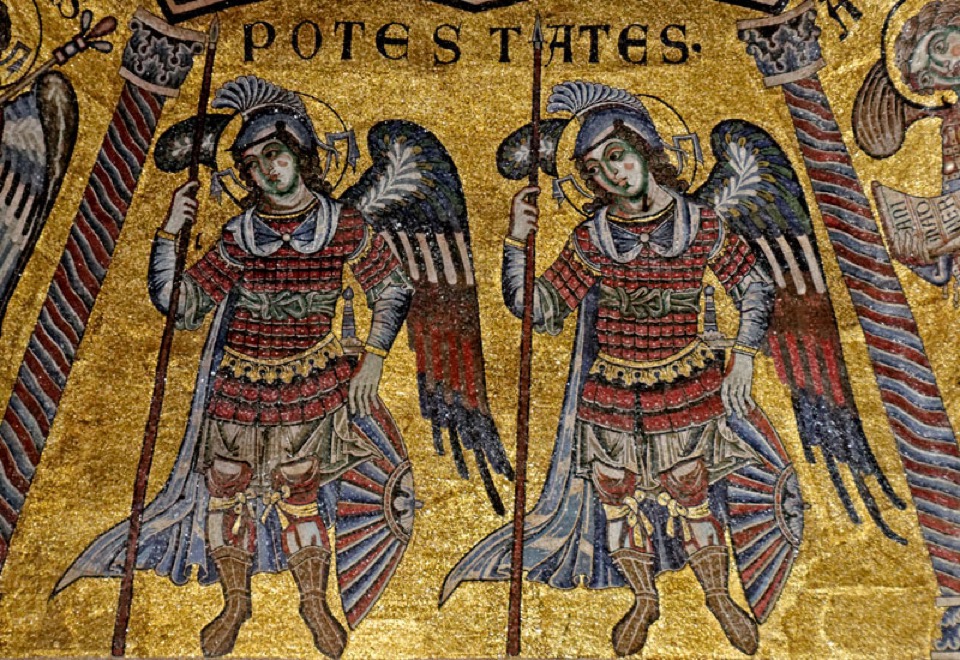
These are two Potestates or Powers (nicely indicated in the mosaic) from the ceiling of the Baptistery San Giovanni in Florence, from ca. 1300.
The Powers (or Authorities) embody all lawful authority including civil. They are warrior angels that fight evil spirits that try to influence the regular movements of the cosmos or of humans. They maintain order between Heaven and Earth.
Some texts place Archangels and Angels as the 'second sphere', and the Angels such a Virtues as part of the 'third sphere'. Dominions are always in the 'second sphere' because they give orders to Archangels and Angels.
In some texts the focus is on Virtues as the Angels of the second or third 'spheres'. Their attributes are energy and strength, and all nature is subjected to their control. The Virtues are clothed in blue and gilded with gold, they have a broad golden crown and a bright star shines above the forehead. Virtues help people strive to sanctify themselves.
The 'third sphere' includes those Angels who guide, protect or are messengers to humans. These Angels are the lowest ranking because they are nearest to man, and presumably furthest from God.
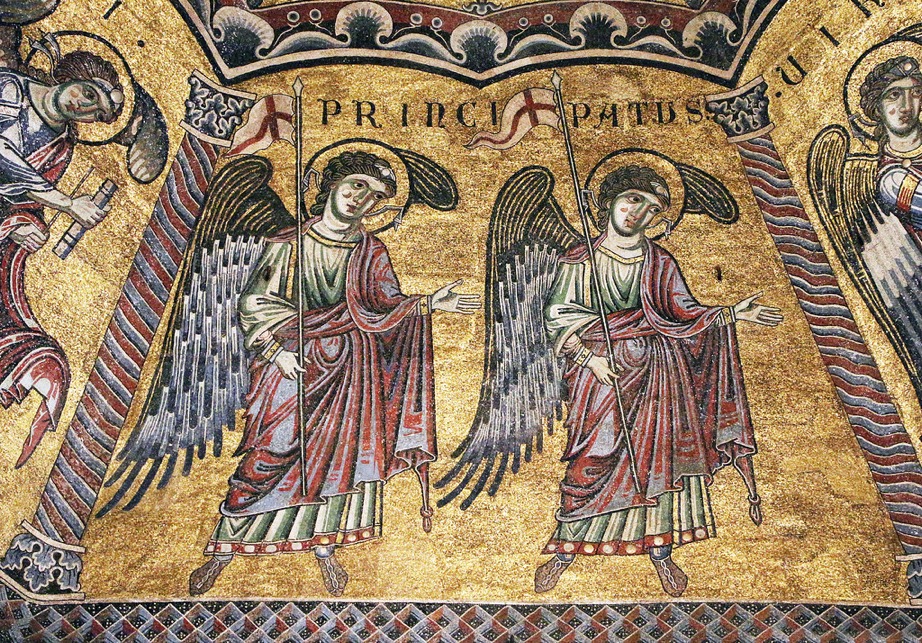
These are two Principalities (nicely indicated in the mosaic) from the ceiling of the Baptistery San Giovanni in Florence, from ca. 1300.
The Principalities (or Rulers) guide and protect nations, groups of people, of institutions such as the Church (i.e. all earthly kingdoms).
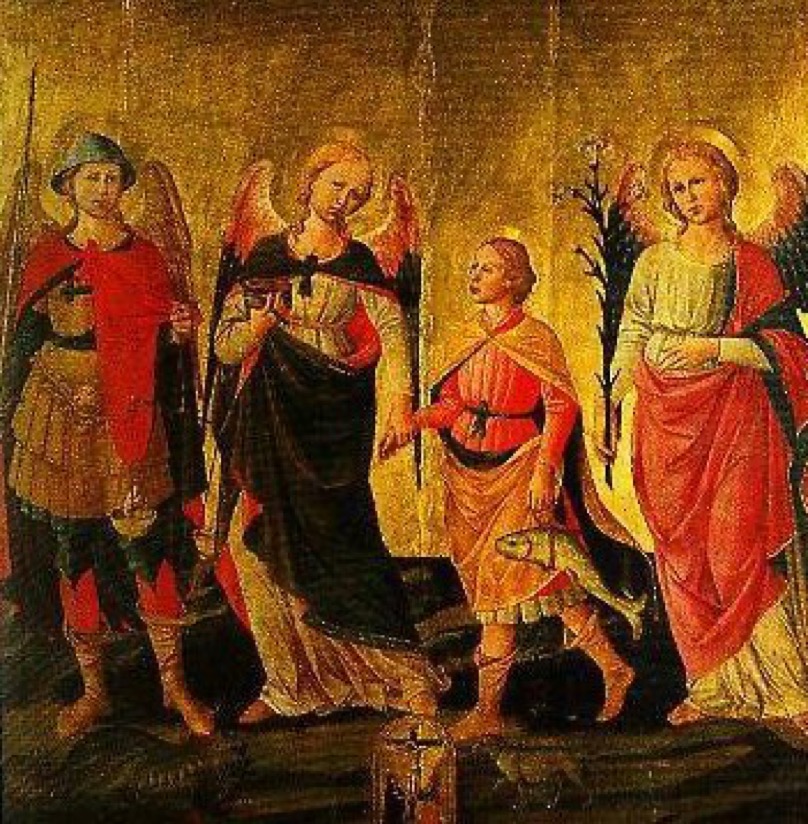
Above we have "Tobias and the Three Archangels" by Domenico Di Michelino (1417-1491). We can see the warrior (Michael) with his tunic and helmet, but which is Gabriel and Raphael? Tobias is carrying a fish, which is usually associated with Raphael. Raphael's relationship with fish is because it is said that he guided Tobias and healed his farther Tobit with the fish's gall (it's a long story so check out the Book of Tobit). So Raphael is associated with guarding pilgrims on their journeys, and he is often depicted with a staff. In this case we can presume that Raphael is the one holding Tobias's hand. So how can we tell that the Archangel to the right is Gabriel? We know that Gabriel announced to the Virgin Mary that she would become the mother of Jesus, the Son of God. And we know from traditional iconography that Gabriel is usually seen holding a lily, from the 14th C a sign of purity.
As an interesting aside, previously Gabriel usually carried a sceptre. The iconography of the lily is typical to Florence, to the point that Siena started to represent Gabriel with an olive branch in his hand. In the Northern European tradition the lily is usually shown in a vase, and Gabriel still carries a sceptre.
Archangels are, of course, high-ranking Angels, and they carry messages or act as envoys to Earth. Only four Angels appear to be known by name and they are the Archangels Michael, Gabriel, Raphael, and Uriel. And only Michael and Gabriel are actually mentioned by name in the Bible, but Archangels in general are the most frequently mentioned. So it's not surprising that Archangels are the richest source of iconography as well. In fact different sources mention a much larger collection of Archangels, along with a whole series of names, but the Lateran Council of 746 AD limited worship to the first three.
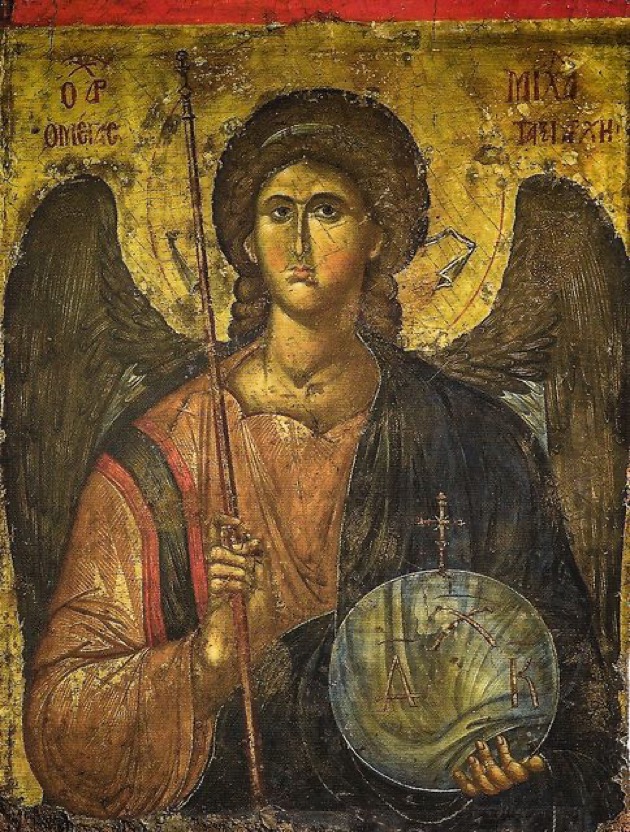
The Archangel Michael stands next to God, and wears clothes like a warrior. It is he that leads God's armies against Satan (who according to some texts is a fallen Angel). Angels of his company also appear as warriors. These Angels are sent to help the Guardian Angels of those persecuted for God's sake. Michael can often be seen holding a pair of scales weighing the souls of the departed, and he may also be seen holding the book of life (the record of whom is destined for Heaven). Above we have a 14th C Byzantine icon with Michael holding a spear and orb. Below we have the Altarpiece of Saint Michael the Archangel, painted by Juan Mates in the first quarter of the 15th C.
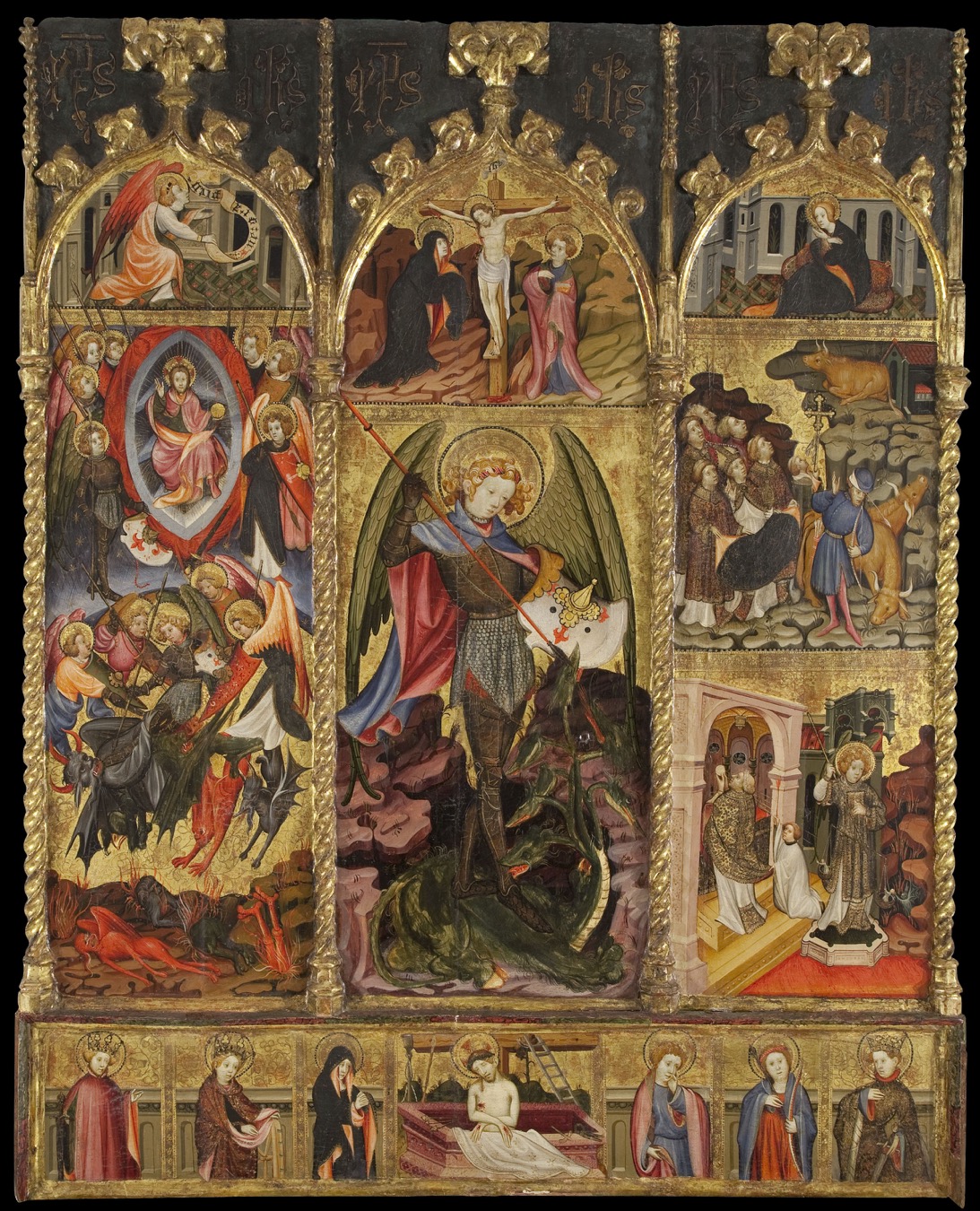
As pointed out in this blog from the Museu Nacional d'Art de Catalunya, up till the early 15th C Michael wore a tunic, but then he appeared as a medieval knight in armour and carrying a lance. At the top we can see an Annunciation with Gabriel as the protagonist, but his appearance is nothing like the usual 'Prince of Angels'.
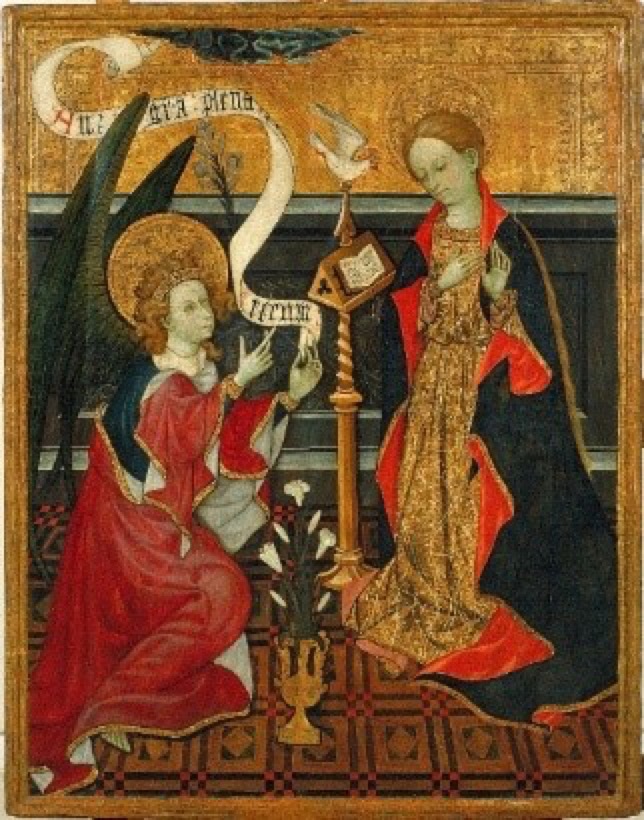
Above we have a typical Annunciation, dated ca. 1410-1430, and by someone throught to be from Valencia. In earlier times Gabriel would have been found along with Michael and Raphael accompanying the dead souls to Heaven. But as the messenger of God, has role grew with time as one of the principle actors in the Annunciation. Because of the importance of the 'message' the iconography of Gabriel did not change very much. He is often a winged figure, young, dressed in dalmatic (a kind of liturgical vestment), and holding a sceptre. Later the sceptre would be replaced by a lily, symbol of purity. Gabriel often is also holding a so-called phylactery, or speech scroll.
The Archangel Gabriel wears priestly vestments, and is responsible for children, priests, and all those who are particularly devoted. It was Gabriel who brought the message to the three kings, and also it was Gabriel who visited the Virgin Mary. From the 15th C Gabriel becomes the trumpeter who announces the Lord's return to Earth for the Last Judgement. In Islam, Gabriel is sent by God with revelations to various prophets, including Muhammad.

Above we have Tobias and the Archangel Raphael, dated from ca. 1470, and probably from the workshop of Andrea del Verrocchio. The early iconography of Raphael involved him, and the other Archangels, accompanying dead souls to Heaven, but gradually the story of Tobias (mentioned earlier on this page) dominated. The Archangel wears a tunic, or is dressed as a pilgrim. Because of the tale with Tobias, Raphael often appears with a fish. What we have is an Angel doctor, healing and guiding.
The Archangel Raphael is responsible for healing, and is associated with an un-named Angel mentioned in the Bible. Raphael is venerated in numerous religions. Raphael also guards pilgrims on their travels, and is often depicted holding a staff.

These are two Angeli (nicely indicated in the mosaic) from the ceiling of the Baptistery San Giovanni in Florence, from ca. 1300.
There are also Angels and Guardian Angels. It is these Angels that we know best, i.e. winged youthful men of light-bearing countenance, frequently wearing white robes, and bringing messages from God. However Angels are not male or female, they just appear as young beardless men. Women with wings appeared much later and are not based upon Christian tradition. Nowhere it said that Angels have wings, and initially they were just young men in white robes. Now wings are like halos, they are not real but symbolise a sense of swiftness, and it underlines their link to the Seraphim and Cherubim, who both actually have wings.
Angels are said to be humble and do not desire the place of those (Angels) greater and more excellently endowed. Guardian Angels are exceedingly numerous and each person has a Guardian Angel forever, in life and in Heaven.
The Guardian Angels of lost souls are allocated to the special guard of the Queen of Angels (the Blessed Mother) where they also have great joy in Heaven.
Some Guardian Angels are timid and are allocated to those who will suffer much. These guardian angels appear dressed in red and wear a small crown.
Other Guardian Angels are allocated to innocent souls, and they always have expressions of joy, wear beautiful crowns, and are dressed in white. For those people who are on the road to perfection, they may receive help from the Virtues and Powers.
Children have lovely Guardian Angels with light blue garments decorated with pearls, they have a wreath of everlasting roses around the head, their hands are always folded in prayer, and their eyes always directed towards Heaven.
The Guardian Angels of sinners have a majestic bearing, and garments of deep red. They have crowns, their arms folded across the breast, and faces turned to Heaven with an imploring or painful expression.
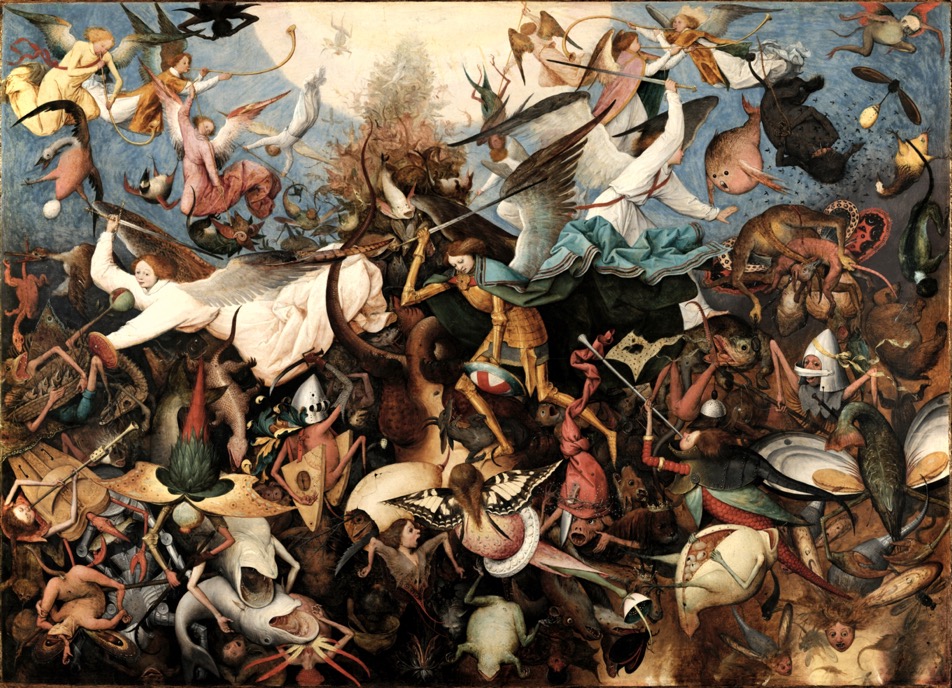
We cannot leave our review of Angels without looking at fallen Angels. These are Angels that committed sins before the beginning of human history. In some texts the sins involved a rebellion against God led by Satan. They were cast out of Heaven and became demons. The above painting is 'The Fall of the Rebel Angels' by Pieter Bruegel the Elder, and dating from 1562.

Angels can occasionally be a bit rebellious. As we can see above from the 'Mirror Historial' of Vincent de Beauvais.

And angels may not always be treated with the greatest of respect. As we can see with the 'feather pincher' from a page in the book of devotional material compiled by Jehan Mansel.
Angels in the Collection at the Thyssen-Bornemisza
Now that we have a better idea about what Angels are, we can try to look at the painting in the collection with a more discerning eye. But we are going to start with an easy one.
The Annunciation by Gentile Bellini
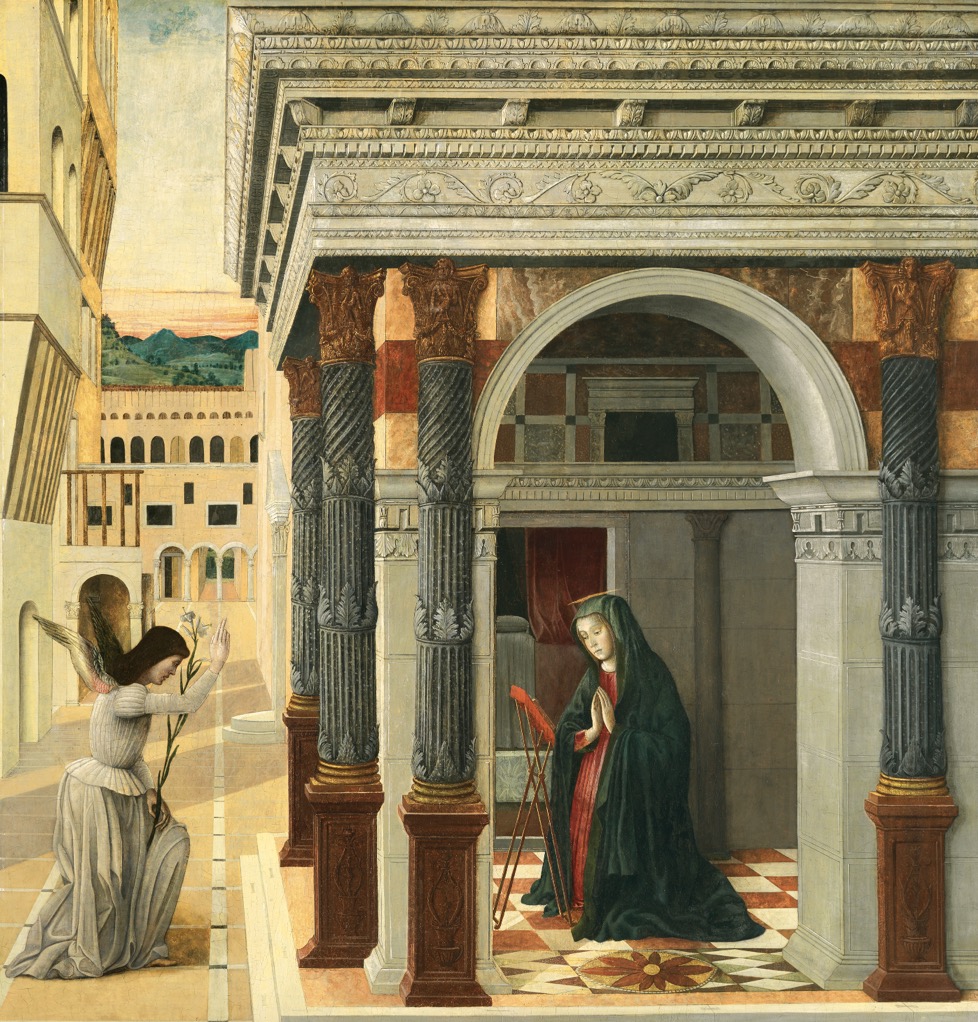
Our first example is 'The Annunciation' by Gentile Bellini (ca. 1429-1507), dated to ca. 1475. Firstly we now known that we are looking at the Archangel Gabriel delivering the message to the Virgin Mary. Gabriel is saying "The Holy Spirit will come upon you, and the power of the Most High will overshadow you". The Annunciation is one of the more frequently illustrated subjects in Christian art, along with the Crucifixion.
We are in front of what looks like a very classical version of The Annunciation, with just two figures, always Gabriel on the left and Mary on the right.
Originally the Holy Spirit was seen as a dove arriving on a ray of light. The 'power of the Most High' was presented as a hand reaching from Heaven, later one might also see a face or upper body reaching from Heaven. In the early Romanesque era Mary gestured to the Angel with her palms held out, but later her hands were clasped in prayer. So Mary changed from a gesture of humility to one of reserve and detachment. She is often clothed in blue, the colour of the Heavenly Realm but also the colour traditionally associated with the Virgin Mary (she is Queen of Heaven). Blue was seen as the colour that bridges the Heaven and Earth, and Mary would be the bridge between earthly sinners and Heaven. By the 14th C blue and red were often used to compliment each other, and many versions of Mary use alternative red and blue clothing. White, used for the Archangel, represented both purity and the eternity of divine revelation. Interestingly Angels could have white clothing with gold decorations, but Bellini has remained quite minimalist.
Usually Gabriel is at a respectful distance from the Virgin Mary, often separated by a column or other architectural detail. Many artists place each on opposite sides of a physical arch. Originally Mary was doing something, such as spinning or weaving. But from the 5th C the Annunciation always occurs inside and Mary is usually sitting on a throne-like chair. By the Gothic period (12th C to 14th C) Mary was engaged in kneeling to pray or studying the scriptures at a book-stand. Flowers appeared in the 13th C, and then started to replace the sceptre in Gabriel's hand. By the 16th C the flowers had been replaced by lilies, representing the notion of purity.
Gabriel originally was a warrior holding a sceptre, but over time he gradually lost the military uniform. From the 15th C additional symbols started to appear, e.g. the hourglass (for the 'sands of time') and the candle (the light of truth).
This Annunciation by Bellini is somewhat different from what might be expected for the period. The city is empty, but the architecture is a dominant feature. The Virgin Mary is kneeling in front of her bookstand. The Archangel is kneeling in a kind of alley leading off to a rich green landscape. We should not read too much into all this, since artists at that time wanted to show they mastered perspective in order to create a sense of depth. However Bellini was known for not quite mastering the correct scale between people and buildings.
The Annunciation to Saint Anne by Bernhard Strigel
We must remember that Gabriel did not just visit the Virgin Mary, he was God's special messenger, so he must have visited lots of people. But there were certainly other messenger Angels. Below we have another painting of an annunciation from the collection in the museum. This time it's 'The Annunciation to Saint Anne' by Bernhard Strigel (1461-1528), dated ca. 1510. According to Christian tradition Anne was the mother of Mary, and therefore the grandmother of Jesus (her husband was called Joachim). This annunciation involved telling Joachim and Anne that they would have a daughter, and that they would call her Mary. In fact what we see is an Angel telling Anne, and through the window another Angel telling Joachim. The Angel is holding a baton or sceptre, so it could be Gabriel, but the actors in this annunciation are depicted with realism and without any form of idealisation (in particular the Angel). Anne is overwhelmed, and it looks as if Joachim is having a friendly chat with his Angel. According to legend Joachim had his offering rejected at the temple because they were childless, so I presume now Anne is crying tears of joy. In any case she is probable not listening, because the Angel appears to be tugging on her headdress to get her undivided attention.
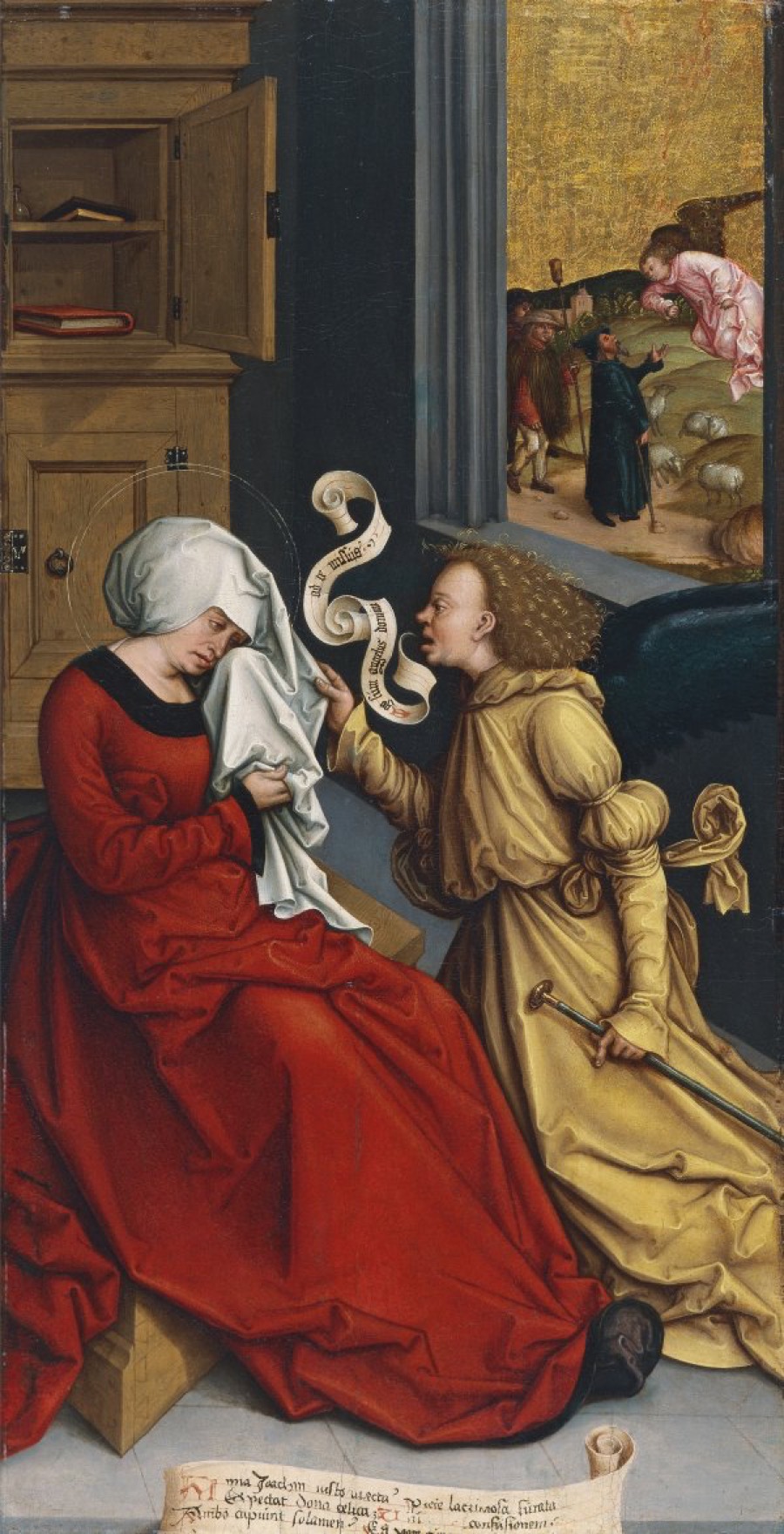
The Assumption of the Virgin by Johann Koerbecke
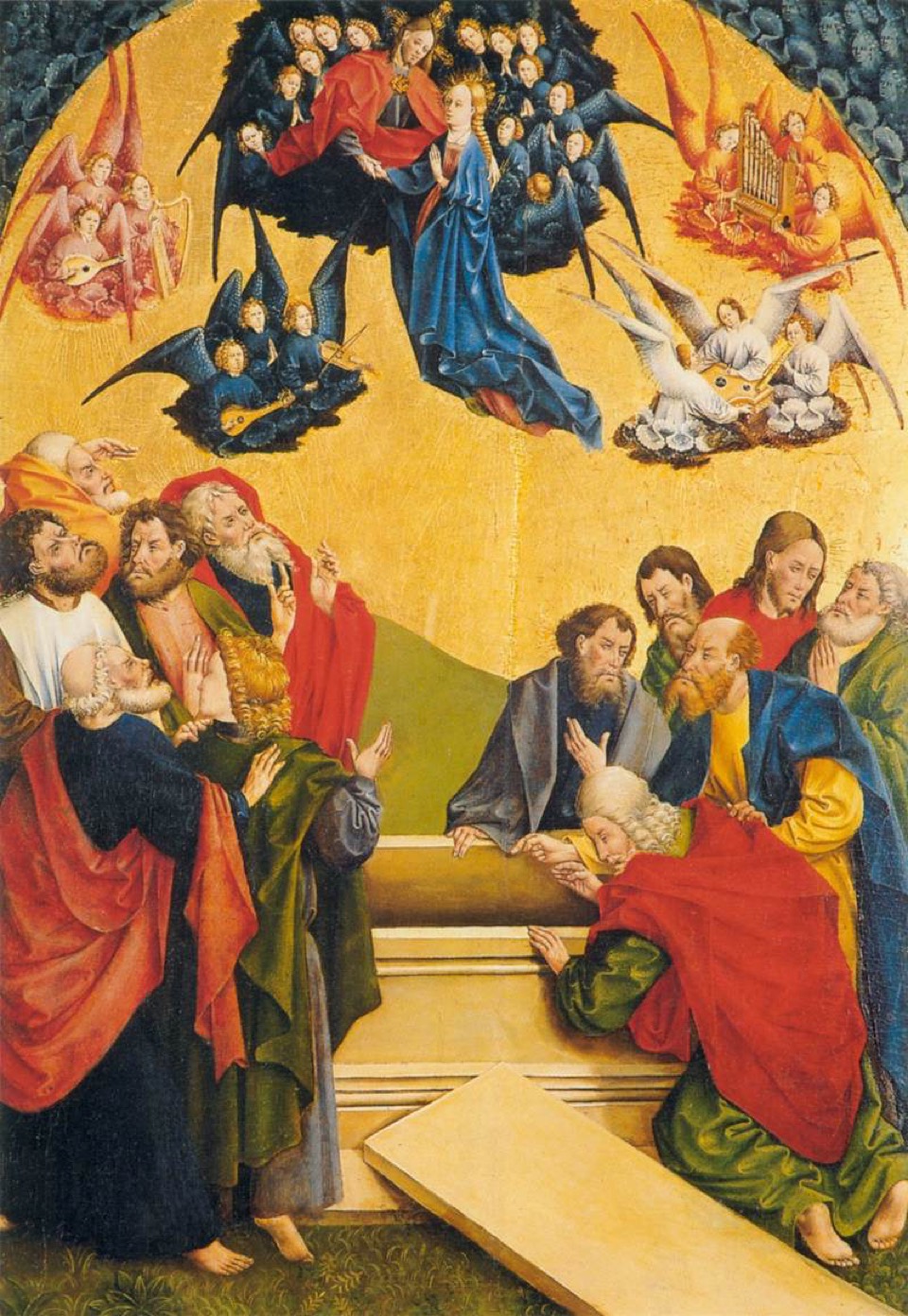
The 'Assumption of the Virgin Mary' is one of the most important inspirational messages in Christianity, and has always been one of the most important topics for painters. This work is by the German Gothic painter Johann Koerbecke (ca. 1415-1491). It would have originally been part of a high altarpiece, and is very much painted in the Flemish style. This panel was the inside right wing of the altar. What we see are the twelve Apostles grouped around the empty tomb, and above Christ receiving the Virgin Mary. This type of presentation with the Virgin Mary hovering over the Apostles was a pictorial tradition in Germany at that time.
The website of the museum tells us that this style went out of fashion, and the altar wings were covered over with paintings from the 17th C. When the monastery was deconsecrated the doors were detached and sent to auction.
What we can see are groups of angels set on a gold background, emphasising the heavenly realm. There are four groups of musical Angels floating on clouds, and Christ is surrounded by Cherubim. They are blue and represent the guardians of the heavenly realm. Another pictorial tradition of the period was to present a host of small Angels with pointed wings. This was a common way to present attendant Angels in Northern Renaissance paintings. About this time the Northern Renaissance painters were becoming expert in inventing intricate variations on a limited number of well-known themes. Slightly later we would also see the Virgin Mary being borne upward by angels, or the Virgin Mary supported by angels and hovering in a majestic manner over the Apostles.
By the 15th C all Angels had wings, and many were also associated in one way or another with music. You can find Angels sitting in the sky holding music scores and singling, other playing lites, harps, and trumpets. The way the Angels are positioned in the sky may have been inspired by the so-called 'roof angels', i.e. groups of singling or music playing Angels painted into church roof corners in the 14th C.
We have to ask if the groups of red, white, blue and orange Angels have any particular significance. There are whole webpages dedicate to interpreting colours as meaning something significant (a lot of wishful thinking), but we must look back to the view of our 15th C artist. The reality is that the Northern Renaissance (Flanders, Germany) tradition included groups of Angels vested in wide-sleeved tunics (e.g. in dalmatics) in much the same way they might include bundles of wheat or grape vines, i.e. decorative elements. Frankly, I don't think the colours of these groups of Angels has any deep significance.
The Adoration of the Magi by Luca de Tommé
In fact once you start to look you find decorative Angels almost everywhere. For example below we have a corner of 'The Adoration of the Magi' by Luca de Tommé, dated to ca. 1360. We see two Angels, one in yellow the other in blue. The fact that both are on Earth, and each has a small crown, suggesting that they might be Guardian Angels. One has their hands across their heart in a traditional sign of reverence, and possible also a sign of humility as a servant of the Lord. The other Angel is praying, a sign of devotion. We can say that they are more than simply decorative, but do not affect the main theme of the painting.

The Nativity of Jacques Daret
Now below we have colourful bunch of three Angels singing on 'The Nativity' of Jacques Daret (ca. 1404-1470), dated to ca. 1434. Generally speaking Angels sing hymns of praise to God. Different texts suggest that singing Angels could be either Seraphim or Cherubim. Specifically Angels singing to the glory of God have always been associated with the Nativity.

This is a small detail in the top left corner of the painting, and it is said that Jacques Daret, after training with Robert Campin, was well known for his decorative paintings with a fine use of colour. In fact this group of Angels is said to have been copied from a model used by Campin.
The Virgin and the Child between Angels by Maestro de la Madonna André
We are going to close this webpage on Angels with two strong and healthy examples. Below we have a detail from 'The Virgin and the Child between Angels' by Maestro de la Madonna André (ca. 1500-?), so dated to after 1500. The artist is unknown, but we do know that he worked in Bruges. And we know that there must have been a link between this artist and Gerard David (ca. 1460-1523), because he also painted a 'Virgin and Child with Four Angels' sometime between 1510 and 1515. The two paintings share the same compositional structure, right down to Bruges being in the background of both.
The Coronation of the Virgin Mary is a well known subject in Christian art, and was popular in Italy during the 13th C to 15th C, however the crowning of Mary by two Angels whilst holding the newly born Jesus is usually considered as a different subject.

The painting includes four musical Angels, two playing instruments at the bottom and two at the top holding the crown. We should remember that the Virgin Mary is the Queen of Heaven, so the theme of her Coronation is found quite frequently. However, the crowning usually takes place in Heaven or in the Sky, and is performed by God or Jesus, not two Angels. In fact the most likely first example of the Coronation of the Virgin Mary shows Jesus crowning the Virgin. Enthronement is often preferred over Coronation because Mary and Jesus are usually seen sitting together on two thrones. This crowning takes place after her resurrection and assumption to Heaven, and not upon the birth of Christ. Some of the earliest examples of the Coronation after the resurrection have an Angel reaching down and placing a crown on the head of the Virgin Mary. The true Coronation pictures began appearing in the 13th C and they eventually became the standard format. A less common model has Mary crowned by the Trinity. She sits between the Son and the Father, and together they place a crown on her head. The Holy Spirit hovers overhead. Initially Mary is seen with her hands forward and palms out, a sign of humility. By the 15th C Mary is either praying, or crossing her hands over her breast.
There are some examples where Mary is sitting with the Child Jesus, and two Angels are flying over her holding a crown (as in this painting). A few comments mention that this is also the crowning of the Queen of Heaven, but there are also comments suggesting that it is a 'different subject' without further elaboration.
References
The website Manuscript Art has a webpage dedicated to 'angels' including the hierarchy of angels herald angels, and 'on angels' wings'.
Holy Angels
Christian Iconography
A Dictionary of Angels, Gustav Davidson
The Development of Winged Angels in Early Christian Art, Therese Martin
The Iconography of the Merode Altarpiece, Margaret B. Freeman
Between Heaven and Earth: the Symbolism of the Angelic Realm, Estelle A. Maré
The Annunciation, Margaret B. Freeman